When starting out with something new, it feels scary and intimidating.
You’re eager to get to your goal, and you know that other people have done it before you.
But quite quickly, questions start popping up in your head, that you, as a beginner, have no answers to.
The exact same goes for social media.
Where do I start?
How do I succeed?
How should I begin?
These are only some of many questions that you, including everyone else, ask when you’re going take on a new area which you are completely unfamiliar with.
But don’t freight. This is where your social media marketing plan comes in. When you know what you’re going to do, and how you’re going to do it, all of a sudden, succeeding with social media doesn’t seem so distant after all.
Your social media marketing plan gives you answers to all questions you might have and might get as you go. It is your blueprint and roadmap for getting to your goal as quickly and effortlessly as possible.
Succeeding with social media marketing demands great planning and great execution, but without a social media marketing plan, you’re operating in the blind. There are plenty of things to consider in order to succeed, but by developing a social media marketing plan, you’re setting yourself up for success right off the bat.
Accordingly, working with social media will become a lot easier, because you’ll know what to do and how to do it when something unexpected comes your way.
So before you dive into the practical part of social media marketing, let’s develop a social media marketing plan together. Because having done so will not only save you a ton of time, but it will also help you better succeed in the competitive social media landscape.
What is a social media marketing plan?
First thing first, I’ve already revealed much of the purpose of a social media marketing plan, but essentially, it can be explained with one word:
Blueprint.
Think of it this way:
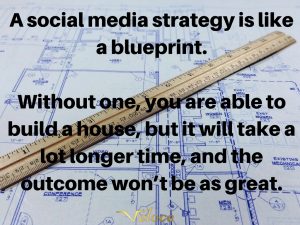
It is a summary of everything you’re going to do on social media, and most importantly how you’re going to do it to help you generate the best possible results.
Every time you come to a roadblock, you should be able to look back on your social media marketing plan and get the answers you are looking for in order to make the decisions that support your goals.
Moreover, your social media marketing plan also helps you evaluate success through success metrics that you’ve set in order to see how well you’ve performed, and how well you’ve worked towards your goals.
Audit your current social media situation
If you haven’t gotten started with social media yet, you can skip this step.
Otherwise, auditing your current social media situation allows you to identify key areas where you can improve, as well as identify things that are currently working for you so that you can elaborate on them.
When you know your current situation, it will be a lot easier to know where you are going.
Which social media platforms are you currently active on?
Which platforms work the best? Which platforms are you focusing the most on?
Are you generating the results you want to see?
If not, why? If the answer is no, at the end of this article, you’ll have a roadmap which helps you get in the position where the answer is yes.
Are your social media profiles optimized?
Are you active on the platforms you have accounts to or are they just sitting and collecting dust? Have you completed all your profiles with consistent profile pictures, bios, usernames, URL, etc?
How does your social media presence compare to your competitors?
What are your competitors doing that you aren’t? What are you doing what they aren’t? (we’ll get more into detail on analyzing your competitors on social media further on, don’t worry!)
Define your target audience
As marketers, we trade on one thing:
People’s attention.
And the reason more and more brands are starting to implement social media marketing into their marketing strategy is that the attention of people has switched, to now being put to a very large extent to social media.
But while social media currently boasts a whopping 2.46 billion+ users, as a brand, you are only striving to get the attention of your target audience – the people who are actually interested in your industry, and therefore might be interested in buying from you.
A huge mistake many brands do is they go out on social media, and then they throw their nets widely, hoping to reel in as many people as possible, without paying any thought to who the people they are attracting actually are.
By defining the people who are actually relevant to your business in your social media marketing plan, you can thereby better develop your social media marketing strategy to be more effective and generate greater results
When you know your target audience down to the smallest detail, you can better develop a social media strategy which resonates with them and gets them interested in your brand.
The more specific you are in your targeting, the better. Obviously, you’d rather have 50 super relevant and targeted followers on social media than 1000 irrelevant followers who have absolutely zero interest in your brand or niche, and this is where many brands fall short.
They’re only looking at the sole number and think that they’ve succeeded, while, in reality, their goal of social media marketing isn’t to build followers but to get marketing benefits from it.
The more specific you are, the better you’ll be able to tailor your messages to suit that audience in order to ultimately get them to convert.
Doing this will save you a lot of time and money.
Accordingly, you want to ask yourself these questions in your social media marketing plan:
- What is the age of your target audience?
- Where do they live?
- What do they do? Study, work, retired, etc. Ideally, you want to take it one step further and ask yourself what they are working with, what they study, and so on.
- What is their income?
- What are their interests and hobbies?
- What are their pain points? Can your business solve these and how?
- Where are they spending their time on social media?
- Which is their favorite social media platform?
These questions are the most basic questions, but to get an even better understanding of your target audience, developing customer personas will be tremendously helpful for you. Developing customer personas (or buyer personas) means creating a fictional character which carries different characteristics which many of your customers have. By developing these fictional characters, it becomes much more concrete when developing your social media marketing plan and campaigns as you always have these individuals in mind and tailor everything you do according to them.
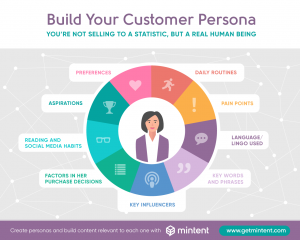
3. Choose social media platforms
This is a major question that every brand ask when developing their social media marketing plan. In fact, I’m sure you’ve asked this question, too!
And since Google gave me 80 300 000 results for the term ”which social media platform should I use”, you’re certainly not alone.
There are literally hundreds and hundreds of social media platforms out there which you can choose from, so inevitably, narrowing it down to just a few might seem like an impossible task.
But here’s the deal:
A common misconception with choosing social media platforms is that you’re going to use every single social media platform you can find. And at first hand, that makes sense. The more platforms you use, the more people you have the possibility of reaching, thus allowing you to generate amazing marketing results.
The only problem is that it doesn’t work that way.
Facebook had over 2.2 billion users in 2017. That’s a ton of people.
But the reality is that you’ll never in a million years, no matter how many of your posts go viral be able to reach all of them.
And what you’re doing if you are using every single social media platform you can come across is you’re spreading your efforts. And what happens when you spread your efforts is that you’ll end up generating average results, or even close to zero results on many platforms, rather than dominating on a few.
Which scenario do you think is the most beneficial marketing wise?
Succeeding with social media marketing demands time, great planning (social media marketing plan), and consistency, but if you only have a few minutes to spare for each network, you won’t be able to do much. And remember, the work you put in is the results you can expect. If you don’t invest a lot of work, you can’t expect a lot of results.
Therefore, it’s much better to choose a few social networks and go all in those.
But how do you choose social media platforms?
Target audience
There are a number of factors that will decide which social media platforms you should be using. First off, it’s crucial that you realize that your target audience isn’t to be found on every single platform. This is also the reason why I emphasized defining your target audience in the point above.
The example I always use is Pinterest.
Pinterest is notoriously known for having a user base where the majority of users consists of females.
What does this mean for you as a brand that has a target audience which solely consists of men?
It might mean that you might be wasting your efforts, as the majority of people you’ll reach from your marketing efforts will be women.
A type of platform that every brand no matter what should be using is Facebook. It is the largest social media platform in the world, and the user base is very diverse which means essentially any type of brand will be able to find their target audience there. Moreover, Facebook is universal when it comes to content, and it supports text, images, links, and videos. This is also the reason why 93% of marketers use Facebook advertising regularly.
Moreover, at first hand, marketers choose the most established social media platforms, and this is probably what you will too, which makes sense. If you choose them strategically, chances are, that’s where most of your target audience will be found.
But just know that whether a platform has 500 million users or 200 million users won’t mean that much, because you’ll never be able to reach those people. What matters is your target audience and if they are to be found on that platform.
Before you dig into a social media platform, first take a look at their user demographics so you know that your target is even to be found there. Because if they’re not, you’ll waste a lot of time and effort on people who don’t matter to your brand.
Content/type of platform
Everyone uses social media for different purposes. This is yet another factor that will play a role in what social media platforms you should choose. Now, I’ll go more into content further on, but you probably have an idea of what kind of content you want to create and share, and you probably have an idea on what type of content you are best at creating.
For instance, you might be terrible at creating videos, but you might have impressive writing skills, and therefore text-based content is the type of content you want to focus on. Accordingly, your choice of social media platforms should reflect that.
Your choice of platforms should support not only your goals of social media but they should also support the types of content you are best at creating. If you feel like the best way to mediate your message and to impact your audience is through video, then YouTube is a platform that is very close at hand.

Time
Another factor you want to consider when deciding which social media platforms to use is time. Not only will this help you decide which social media platforms you’re going to use, but it also helps you decide how many platforms you’re going to use.
This also ties together with what I said about earlier about spreading yourself thin.
Obviously, if you have a ton of resources to manage your social media platforms properly, there’s absolutely nothing wrong with using multiple social media platforms. In fact, giant corporations like Adidas and Nike have an endless number of social media accounts on each social media platform, devoted to different things, and speaking to different audiences. But they can have that because they have the resources for it – without compromising on quality.
(While several of the accounts in the video didn’t belong to Adidas, many did!)
But if you’re running a one-man show, replicating their strategy will only be a surefire way to set yourself up for failure and burnout.
So, let’s say that if you were to use YouTube, you need to ask yourself: ”If I were to use YouTube, how many videos would l want to share weekly”. Then, you need to ask yourself if you have the time to create that number of videos. For instance, creating a picture is normally less time-consuming than creating a video, and if it turns out you don’t have the time to create the number of videos you should be creating if you’re using a video-centric platform, then it’s best to use other platforms.
This also ties together with skills and expertise. It goes without saying that if you have absolutely zero knowledge in how you create videos, and you don’t have the resources to take help, then using a video platform is probably not the way to go.
Define your social media marketing plan objectives and goals
You are or want to use social media for a reason right?
If you’ve seen the incredible social media marketing statistics that social media is able to generate, you probably also know that social media is a tool which you can use to work towards a number of different marketing metrics and goals.
Now, before you begin with any type of marketing, including social media marketing, you need to set goals for what you are hoping to achieve. The main reason you define your goals and objectives in your social media marketing plan is that it allows you to create campaigns which help you get closer to your gals. Moreover, having defined them allows you to look back every now and then to ensure that your actions are supporting your gals.
If your actions don’t support your goals, then what good are the goals, because you’ll never achieve them, right?
Lastly, your goals will be tremendously helpful when it is time to evaluate and measure success from social media. When you have set goals, you can effortlessly look at the results and see if you have achieved your goals, almost achieved your goals, or not even come close to them
If needed, you can then tweak and improve your strategy so that it actually allows you to reach the goals you want to reach.
Additionally, it is also helpful if you make the goals of your social media marketing support a larger business goal, and make them aligned with your overall marketing strategy.
“If you cannot measure it, you cannot improve it.”
Now, before we dig into the practical part of setting goals in your social media marketing plan, we need to sort out a common mistake which makes brands make when it comes to setting goals.
That mistake is that far too many get hung up on the most obvious vanity metrics on social media, such as followers, likes, and retweets, and use them as some kind of success evidence.
But really, when it comes to actual business results, those results aren’t interesting. It is what those vanity metrics reflect and resemble that is interesting.
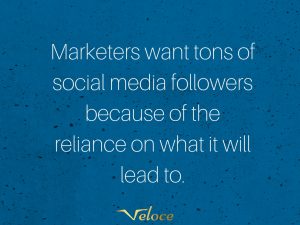
For example, that you have received a total of 543 comments on your posts this year is not interesting. The interesting part is what those comments mean, and more importantly, say.
Sure, receiving lots of comment might reflect the fact that you have an engaged audience, but having an engaged audience isn’t a real marketing objective. Instead, your goal should be to make your customers more loyal and become returning customers with the help of social media.
As such, it’s also important to know that all marketing objectives and goals are all rooted in one thing: to help you sell more.
That’s the only goal a business has.
Sure, you might say that ”no, our goal is to gain more traffic”, but when you start asking why quite soon you realize that the end goal is always sales.
This is why it is crucial that you ask the question ”how will this objective support our only mission, which is to sell more?” The answer might be that it supports that goal very closely, or, it might mean that it supports it on a very micro and long-term level.
But just know that setting the goal ”grow 10K followers” is itself not a real metric you want to focus on.
Now, this does not mean that you shouldn’t set those goals, but it means that you need to be very self-aware of why you want to achieve that goal. if the answer is that it helps you grow a larger audience, which in turn means that you can impact a larger number of people, which in turn means that you’ll be able to sell more, then great.
But if the answer is ”because it looks good and I don’t care about who those people are”, I’d be very careful.
When setting goals in your social media marketing plan, you should, of course, do it according to the S.M.A.R.T. goal-setting principle:
A good start is setting three main goals. You can (and should) also create a few bi-goals, which support your main goals.
For example, a goal of yours might be to drive direct sales through social media, and a bi-goal of that might be to use social media to build relationships with prospects, which, in turn, can lead to sales.
As you know by now, there are two types of goals and objectives on social media. The first type of goals are the typical business goals which go for all marketing efforts, such as increased sales, more traffic, and more newsletter subscribers.
Then, there is the type of goals which are more focused on social media metrics, which, in one way or another are meant to reflect and support the first mentioned metrics. This includes things like engagement rate, followers, and retweets.
Some common metrics that are used within the two areas are:
Marketing metrics:
- Sales
- Website visitors
- Time Spent on Website
- Newsletter subscribers
Vanity metrics are often things like:
- Reach
- Total Shares
- Sentiment
- Brand Mentions
- Likes
- Followers
Complete your profiles
Now, you’ve already evaluated your current situation on social media. If you have a social media presence, you might have realized that you need to update and complete your profiles to make them more attractive.
If you don’t currently have a social media presence at all, you need to start from scratch and create your accounts, and then complete them.
On social media, your profile is most likely the first thing people will encounter when they come across your brand on social media, and therefore, you want to make sure it is attractive and gets people engaged to further explore your brand. Think of your profiles as your storefront, because essentially, that’s exactly what they are. The face out to the public.
Not only do you want to set up your profiles and then kick your feet up, but you also want to regularly check back on them so that they are consistent and up-to-date.
One of our monthly checks here at Buffer is to visit each of our social media profiles and make sure that our profile photos, cover photos, bio, and profile info are up-to-date and complete. It’s a key part of our social media audit. A completed profile shows professionalism, cohesive branding, and a signal to visitors that you’re serious about engaging.
Profiles will require two parts: visuals and text.
The first thing you want to do when setting up or optimizing your profile is fill out all the empty fields. This will give your audience the information they need, and hopefully make them more interested in your brand. Moreover, when doing this, you should also set up your profiles in a cohesive manner so that they look similar across social media platforms. Doing this will not only help for visibility and discoverability when people are looking you up on different platforms, but it will also help you run consistent branding.
Images are an important part of your consistent branding when it comes to your profiles. As a brand, it is best to use your logo as your profile picture and use it consistently across platforms. Moreover, the cover photos you use should also be similar or identical to each other.
Bio/description
Your description is probably the most important part of your profile. A great bio can captivate people, give them the information they need, and give context to your brand. The point of this is ultimately so that you spark interest in your brand in the people who come across your page, and therefore, it is important that you put great thought into what it is you are writing. Ideally, you also want to sprinkle your bio with a touch of personality so that it resonates with the customer personas you’ve developed, which is your target audience.

If the personality of your brand is reflected in your bio, the people who come across it and are in your target audience are much more likely to resonate with you and stay.
Develop your voice and tone
Your brand personality and the voice you use it incredibly important on social media. People who are on social media want to have a good time and engage with other humans. And remember, humans, resonate with other humans. If your personality on social media makes you come off like you are just a soul-and emotionless robot, you will have a hard time building relationships with your audience because they’ll feel distant toy your brand.

Obviously, as a brand, you want to develop a brand voice and a personality which resonates with your brand and what you stand for, but that personality should also reflect the audience you’re targeting.
A helpful tactic in developing your voice is, therefore, to look at your target audience. What personalities do they have? And most importantly, what language do they use?
There’s a reason why you resonate very poorly with large corporations that use a language that makes you fall asleep. It shows no personality.
The most famous example of a brand that has understood the importance of developing a unique voice and tone is Wendy’s. And they’ve developed a nice which resonates incredibly well with their target audience. Which, is not that strange, really, considering the voice is created with them in mind.
Wendy’s has developed a sassy, relaxed and fun personality which has lead to them building an incredible relationship with their audience on social media:


A common misconception is the that by developing a voice and tone with personality, you remove your professionalism, but the fact of the matter is that one doesn’t have to exclude the other.
To help you come up with a brand voice and personality which you can define in your social media marketing plan and then follow consistently, here are some questions to ask:
- What personalities do your competitors have on social media? How well do their customers resonate with them? (This is relevant because you’re targeting the same audience, and asking this question can give you an idea of what your target audience resonates with)
- What kind of personality don’t you want your brand to have?
- What do you want your brand to stand for?
- How do you want your brand to be viewed by your audience?
- How do you want your relationships with your customers to look like?
Now that you’ve been able to develop your brand voice and tone, you also want to ask yourself if this personality supports your goals on social media in a macro.
Research your competitors on social media
Taking a look at what your competitors are doing and how well they’re performing on social media is incredibly helpful when developing your social media marketing plan.
It isn’t crucial to developing your social media marketing plan, but it is definitely helpful and can help you win over your competitors on social media.
(If this isn’t important for you, and you have no interest in dominating on social media within your industry, go to the next step).
The main benefit of looking at your competitors who are already using social media is that you can learn what works and what doesn’t.
But when doing so, you obviously want to identify the competitors which are succeeding on social media and which of them aren’t performing very well.
Otherwise, you might end up looking at a competitor which is completely failing on social media and taking after what they are doing, and this isn’t something you want to be doing.
Something you shouldn’t be doing, however, is looking at your competitors and straight off steal and replicate what they are doing. Because by the time you’ve implemented what they are doing, they are already on to the next thing as what they did in the past has stopped working. In other words, if you do, you’ll always remain number two.
But that is not to say that you can’t learn a lot from them.
Identify your competitors
The first step is to identify who your competitors are.
Doing so won’t be that difficult, as chances are, you probably know who they are. Now, you just need to look them up on social media.
Identify which platforms they are using, what they are doing on the different platforms, and then, try to rank them based on how well they’re performing on the different platforms.
If you have no idea who your competitors are, searching for industry keywords together with social media or a social media platform will give you a number of search results which you can dig into.
When you’ve identified the top players who seem to be performing well on social media, break down their strategies in order to understand what it is they are doing that makes them succeed. Then, you want to implement this into your social media marketing strategy.
Begin by breaking down these areas, as these are most critical to social media success:
- What type of content are they sharing? What content seems to work best, and what seems to receive less engagement? Are they sharing different types of content on different platforms? How often do they share content on the different platforms?
- How active are they on social media and across the different platforms?
- How engaged is their audience?
- What captions do they use? How well is their audience resonating with their captions?
- What campaigns are your competitors running on social media? Which type seems to be most effective?
- What industry leaders and influencers are they working with?
When you’ve answered all of these questions and written them down in your social media marketing plan, you’ll have a pretty good idea of how the market in your industry looks like on social media, and what your audience resonates with. The information you’ve extracted from this should ultimately affect how you’re developing your social media strategy, including things like the type of content you should share and what topics your audience might find interesting.
Develop your content strategy
Your content strategy is a crucial part of your social media marketing plan.
The content you share on social media will be the most significant deciding factor to your social media success, because, without content, you have no value proposition, thus giving no reasons for people to follow you or even go to your profile.
Every social media platform is content driven, and without content, you just won’t succeed.
While sharing a few posts without paying too much attention to what you posted may have worked back in the days when social media was just a baby, it definitely isn’t going to work today. Today, more content than ever is being put out on social media, and only the very best will be able to cut through the noise and make it to the top.
This is why quality content is crucial for success on social media. Not just that you’re sharing content.
Lastly, the content you share on social media is also what you will impact your audience with and gain marketing benefits from. It’s quite hard to impact someone if you have nothing to impact them with, whether it be a video, photo, or graphic, right?
Since content plays such a central role of social media success, and thus also in the social media marketing plan, there are a number of questions that I see are constantly being asked around the web regarding it.
And it seems no matter how many answers there are, the questions still seem to be asked. This is why I’ll answer them once and for all.
Common questions that are constantly being asked related to social media content are:
- How often should I post?
- What should I post?
- When is the ideal time to post?
- What’s the ultimate number of posts I should share per day?
And the boring answer to this question is that there is no universal answer that goes for everyone. Mainly, it depends on your audience, because after all, it is for them you are sharing content.
But don’t worry, I won’t leave you at that, though.
Here are the factor that you should consider in order to get answers to those questions that are true to you.
How often should I post?
The question ”how often should I post” and ”what’s the ultimate amount of posts?” can be answered in the same answer, because really, there are only 24 hours in a day, and that will decide how many posts you’ll be able to post.
There is no real answer to these questions other than that you should experiment and try your way to the ideal number of posts.
There have, however, been a number of studies made on this which have found ”the ideal number of posts” for the different platforms.
But you shouldn’t follow these studies blindly, because the real answer differs from account to account based on your audience, but they are, however, great to use as a starting point.
There have been numerous studies on this, and as you’d expect, all of them have found different numbers, and so, it’s important that you take the numbers with a pinch of salt.
This is what DowSocial found:
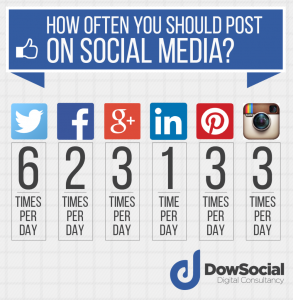
What should I post?
This is the single most important part of your content strategy. Why?
Because the content you share will have the greatest impact on your success on social media, and it will also affect whether or not you are able to cut through the noise.
The most obvious answer is that you should post content which interests your target audience, but the important part is that the content you share provides your audience with value in one way or another.
When you provide value, all of a sudden, you put yourself in a position where you have power since you now have something that your audience wants.
As entrepreneur Gary Vaynerchuk says, when you provide value, you have the leverage.
https://www.youtube.com/watch?v=x1KWXFQ-Ysc&t=508s
There are a number of ways you can provide value with the content you share on social media and here are the most common ways:
- Share content that is informative
- Share content that entertains and makes your audience laugh
- Share educational content
Since content is such an important ingredient for social media success, it is crucial that you have a content strategy that is fine-tuned to perfection. Something you can never neglect, however, is that your content should always be high-quality, no matter what. Today, anyone can create a piece of quality content, even with their phone. There’s so much content that is being put out, and if yours isn’t up to quality, it will just get lost in the noise where no-one finds it.
Another important thing to consider is the type of content you’re going to share on social media.
This is also dependent on which social media platforms you’ve decided to go for.
The most popular types of content being shared on social media are photos, images/visuals, videos, infographics, text, blog posts, and cartoons. Hence, these types of content can be divided into numerous sub-categories.
If you’re using Youtube, for instance, you have no other choice than to create videos, but quite soon, the questions ”what type of cinders should I create?” and ”how should I create them”, together with plenty of more questions start popping up.
When deciding these things, you want to make decisions that support your goals.
If your goal with social media is to make your brand more transparent and audience more engaged with your brand, then you need to create content that supports that goal. This can include things like broadcasting live videos where you interact with your audience in real-time, share behind-the-scenes videos, interview employees, and much more.
The opportunities are endless, really. What is important though is that the content you create and share supports your goals of social media.
Something worth noting is that video has dramatically increased in popularity, both on the consumer end, and also from the distribution end, which isn’t really that strange since where there’s a demand, there will be a supply. This is something worth considering.
The statistics also speak in favour for video content, especially in marketing. As an example, 90% of users say that product videos are helpful in the decision process.
When deciding what to post, try to understand what type of content your audience finds interesting. As you go, you’ll be able to get a better understanding of what type of content works well and what doesn’t, but when starting out, keep the topics related to your industry since you know that your target audience is interested in your industry. It is also helpful to have in mind what type of content your competitors are sharing, and looking at which topics their audience seems to be enjoying.
When should I post?
Another question that is being asked all over the web is this.
As with every other question, the answer is that it depends. But the answer to this question is more dependent on your audience than anything else. This is why you shouldn’t turn to studies to find the answer.
The idea of finding the ultimate time to post is to find a time when the majority of your audience is awake and online. Doing this ensures that the most people possible are likely to not miss out on your content.
A first step to doing this is understanding where your audience is based. It’s clear that the ultimate time for you won’t be the ultimate time for someone who has an audience which is from Europe whereas the majority of your audience is based in the USA.
To get the answers, your best go-to source is your analytics.
On most social media platforms, you have analytics which tells you when most of your followers are online and active.
For instance, if I go to my Instagram Insights, I can see that the best day to post (for me) is on Thursdays.
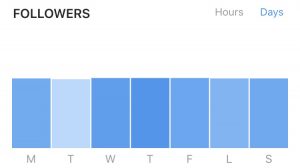
And if I narrow it down to time, I’ll find that the best time to post is between 6 and 9 pm.

Something that is also worth nothing is that the ultimate times to post may also differ between the different platforms. In other words, the ultimate time to post on Facebook for you might be completely different from the ultimate time to post on YouTube.
Just like when you learn what type of content your audience likes, you’ll eventually also start identifying the best times to post on social media are for optimal engagement.
Analyze and evaluate
This is a tremendously important part of your social media marketing plan, because if you don’t know well you’re performing, you’ll never be able to improve and optimize for greater results, nor will you be able to know when things you’re doing on social media are straight up damaging your brand and results.
This is where having set goals come in handy.
Your main goal of social media is to achieve the goals you’ve set, so this is where you want to start.
Have you achieved your goals? Have you exceeded your goals? Have you underperformed?
it is only when you know the answers to these questions that you can improve and optimize.
Something that I hear all the time is that it isn’t possible to measure results or calculate the ROI of social media, but that is just not true. Those who are saying that just don’t know how to do it, and in the post How to measure ROI of social media, you’ll learn that it is, in fact, possible to do it.
Just like when setting goals, you don’t want to get too caught up in vanity metrics like followers and likes when measuring results, but what you do want to do, however, is try to understand what type of marketing benefits those numbers reflect.
Measuring vanity metrics
In your social media marketing plan, you want to have a strategy for how you’re going to measure the results of your efforts, and the vanity metrics are the most obvious place to start.
Let’s say that you are going to begin at your follower count.
The follower count itself doesn’t prove any marketing results whatsoever, but what they potentially reflect is the interest in your brand on social media. But in order to understand if that interest actually benefits your brand, you want to take help from analytics to understand who those people are. If those people are people from your target audience, that means you’ve done a great job at targeting them, and accordingly, having lots of followers will be beneficial, as you are able to reach and impact them over and over.
Most social media platforms have built-in analytics that you can take help from, and there is also an array of third-party analytics program for social media that will give you more rich insight about your audience.
The third-party analytics dashboards are quite popular when it comes to measuring results as they can often give a much more detailed picture of the results you’ve been able to generate.
With Instagram Insights, for example, you can see where your followers are from, what gender they have, and what their age is.
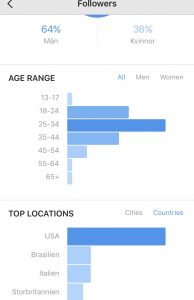
Measuring marketing benefits
You’re using social media to gain marketing benefits, so this is what you want to focus on when measuring results in your social media marketing plan.
Certain things are quite easy to evaluate such as sales generated from a specific social media campaign where you shared discount codes with which you can track the sales and where they are coming from.
Things like website traffic can also be found inside the analytics so you can get an idea of how interested and engaged your audience is to find out more about your brand – or even buy from you,
I often emphasize the fact that social media is a relationship tool and not a promotional tool, and this is why the sentiment of what your audience is saying is something that is incredibly valuable to look at.
Some might just look at the number of comments and say ”awesome, we generated X amount of comments”, but what’s really interesting is what those comments say, because they reflect how well you’ve been able to impact them, and how well you’ve been able to turn them into loyal fans from being potential prospects.
When looking at the conversations on social media, you don’t only want to stop at the comments you are receiving on your posts, but you also want to look at what your audience is saying about you outside of your posts, and listen to the conversations they have about you.
If you, from your social media presence, have been able to make your audience engaged, which has sparked discussions and topics related to your brand, that’s great news, because it proves that you have, with the help of your social media presence, impacted them in a way which has lead to them becoming more loyal and engaged.
This is why it is important to go further than just looking at the sole number,
Have a strategy for social media engagement and customer interaction
This is an aspect of social media that is, unfortunately, far too often neglected.
And I’ve said it before but I’ll say it again, social media is called social for a reason. You’re meant to use it as a relationship tool and as a direct connection with your audience with which you can engage and interact with them.
Engaging with your audience lays the foundation for success on social media through an engaged and loyal audience, and the truth is, people who write to you expect you to reply.
In fact, the people who don’t write to you, but talk about you indirectly can be positively impacted by you listening and engaging.
Every opportunity you can get to customer interact, you should take, and this is why it’s crucial that you’ve defined a strategy for customer interaction in your social media marketing plan.
Moreover, have a plan for how you’re going to handle customer service on social media.
Since more and more people are using social media, and spending more time than ever on it, social media has become a natural outreach channel for getting customer service from brands. And people expect you to respond quickly, too.
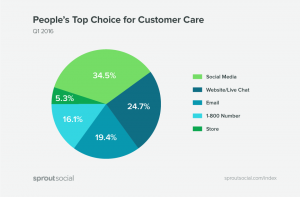
In fact, a SproutSocial study found that people expect brands to respond within 4 hours, so make sure you do!
Allocate the resources needed to get the job done, and never miss out on opportunities to engage with your audience.
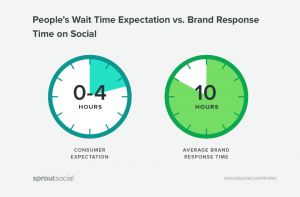
Conclusion
Far too many brands and marketers make the mistake of jumping directly into social media marketing without having a plan of execution or no real idea of how they will succeed with using social media as a marketing tool and gain marketing benefits from it. As you can see from this article, there are a ton of things to have in mind, and creating a social media marketing plan not only allows you to actually think about hese questions, but actually come up with answers and define them. By creating a social media marketing plan, you set yourself up for success. While it might seem unnecessary to create one, in the long term, you’ll otherwise regret that you haven’t created one.
How are you developing your social media marketing plan?
Are you developing it according to this in-depth format or are you adding your own personal tweaks to it?
Let me know how you plan on making your social media marketing plan in the comment section below!


